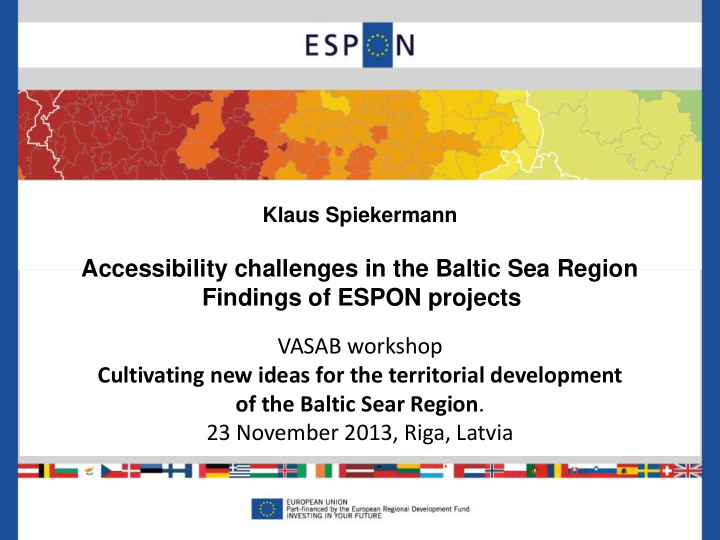



Klaus Spiekermann Accessibility challenges in the Baltic Sea Region Findings of ESPON projects VASAB workshop Cultivating new ideas for the territorial development of the Baltic Sear Region . 23 November 2013, Riga, Latvia
Accessibility • main 'product' of a transport system • determines the locational advantage of an area (i.e. in ESPON a region, a city or a corridor) relative to all areas (including itself) • indicators of accessibility measure the benefits households and firms in an area enjoy from the existence and use of the transport infrastructure relevant for their area. • The important role of transport infrastructure (i.e. networks and transport services) for spatial development in its most simplified form implies that areas with better access to the locations of input materials and markets will, ceteris paribus , be more productive , more competitive and hence more successful than more remote and isolated areas.
Accessibility in the Territorial Agenda 2020 Territorial Priorities 1) Polycentric and balanced territorial development • Avoid polarisation 2) Integrated development • Rural, peripheral and sparsely populated territories may need to enhance their accessibility • Improve accessibility of urban centres from rural areas • Ensure necessary availability of job opportunities and services of general interest 4) Global competitiveness • Integration of local endowment into global economy
Accessibility in the Territorial Agenda 2020 Territorial Priorities (cont.) 5) Improving territorial connectivity • Fair and affordable accessibility to services of general interest are essential for territorial cohseion • Secure access to road, rail, water and air transport • TEN-T • Linking primary and secondary networks • Encourage accessibility of urban centres in peripheries Making EU territorial cohesion a reality Taking territorial impacts into account during policy development can help to avoid creating barriers to implementation and unintended side effects.
ESPON TRACC set of accessibility indicators Spatial Basic Generic type of accessibility indicator Context characteristics Travel cost Potential Cumulated opportunities Access to Global travel Global potential Global Travel global cities connectivity accessibility travel Global freight Global potential Freight Access to global freight hubs connectivity accessibility freight Europe Travel Access to top ten European daily European potential MEGAs accessibility travel accessibility travel (traditional) Travel Travel speed Urban connectivity European potential acc. intermodal travel (new) Access to nearest European daily European potential Freight maritime ports accessibility freight accessibility freight Regional Travel Access to high-level Availability of urban National potential transport infrastructure functions accessibility travel l (Europe-wide) Freight Access to Availability of freight National potential freight terminals terminals accessibility freight (Europe-wide) Access to Regional potential Travel (case Daily accessibility of regional centres jobs accessibility studies, tradit.) Access to Availability of Travel (case Potential accessibility health care facilities secondary schools to basic health care studies, to SIG)
Travel time to New York Intermoda Minutes l
Access to global freight hubs (Shanghai) Sea maritime generalised costs ( € /ton)
European potential accessibiity intermodal (ESPON space = 100)
Urban connectivity (3/5 hours) Road Air
TRACC Regional case studies
Conclusions (1) Different transport modes have very different spatial • patterns of accessibility in Europe. -> ranging from traditional core-periphery pattern to new forms of core-periphery pattern with respect to European and global accessibility Spatial disparities of accessibility continue to exist • for all modes of transport -> transport infrastructure and service development was not able to change the overall European pattern -> road and rail investments of the past was in absolute terms in favour of core regions to Capital regions of the Baltics perform around • European average, rural areas clearly behind
Conclusions (2) Transport infrastructure projects and improved transport • services can have substantial impacts on potential accessibility of individual regions . -> In particular, new high-speed rail and flight services are able to reshape the European continent in terms of accessibility by bringing high accessibility to regions outside the European core However, priority in new member states was given to • road infrastructure development, rail projects are lagging behind. And, transport infrastructure development is clearly • motivated by national interests , i.e. there seems to be a lack of common European sense.
Conclusions (3) Cohesion Past and future transport infrastructure developments reduce disparities in accessibility and GDP per capita between the old and new member states in relative terms. However, in absolute terms , they widen the gap in accessibility and GDP per capita between the old and new member states. In particular the Nordic countries demonstrates that other regional assets might overcome low accessibility.
Conclusions (4) Local and regional accessibility Huge differences within the Baltic States exist concerning accessibility to opportunities relevant for daily life. In particular, access to services of general interest varies enormously within the countries. A balanced development of opportunities is required. Freedom of choice , e.g. in the selection of secondary schools, not supported by the combination of locations of services and the transport system. Vicious circle with rural areas at risk to be underserved.
Further Information www.espon.eu • – ESPON Accessibility Update Studies – TRACC project www.spiekermann-wegener.de • Dr.-Ing. Klaus Spiekermann • Spiekermann & Wegener, Urban and Regional Research (S&W) Dortmund, Germany ks@spiekermann-wegener.de
Recommend
More recommend